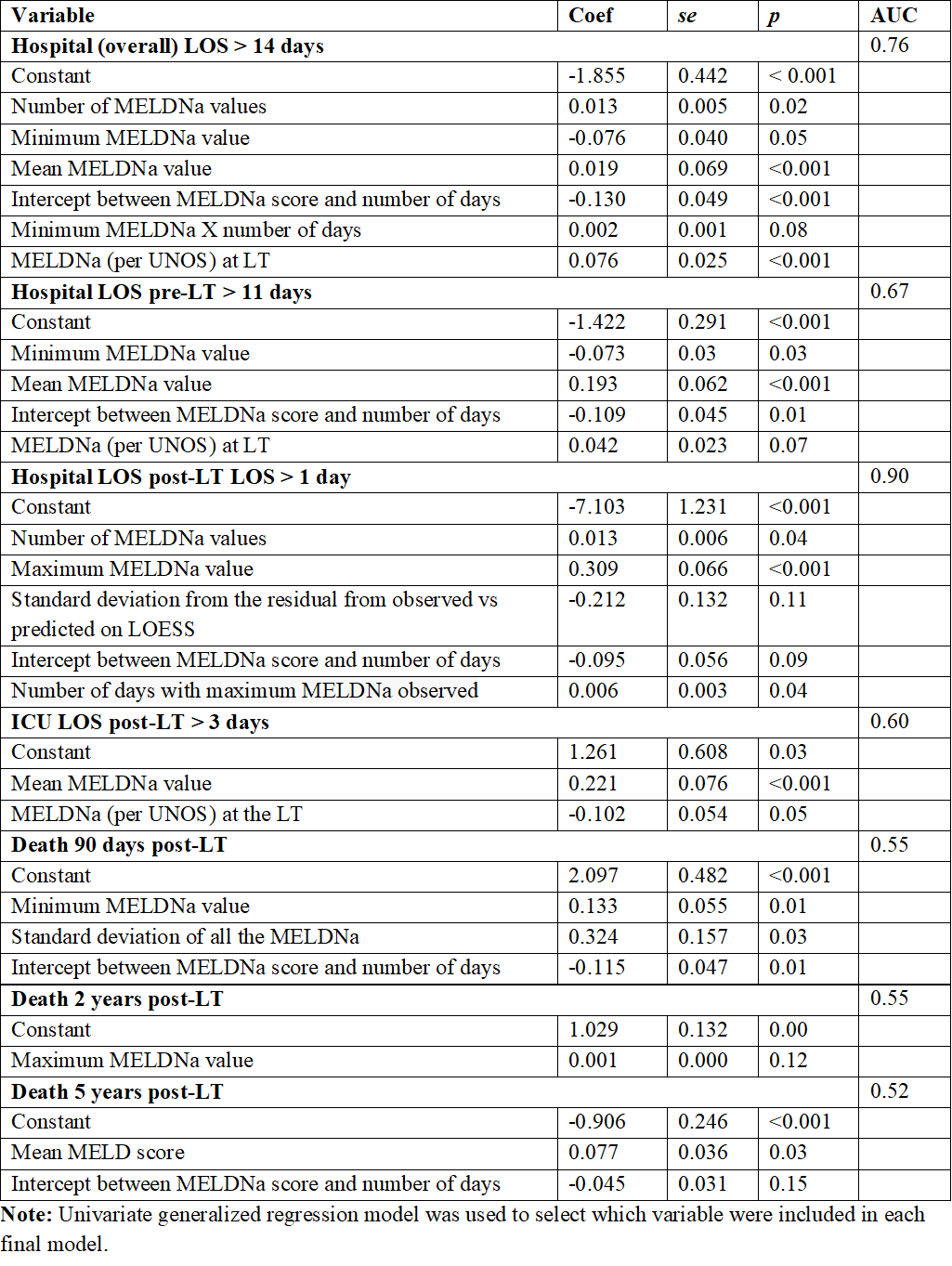Waitlist Meldna Variation One-year Prior To Liver Transplant Predicts Length Of Stay At The Time Of Transplant
1University of Minnesota, Minneapolis, MN, 2Cleveland Clinic Foundation, Cleveland, OH
Meeting: 2022 American Transplant Congress
Abstract number: 9037
Keywords: Length of stay, Liver transplantation, Multivariate analysis, Prediction models
Topic: Clinical Science » Liver » 51 - Liver: Retransplantation and Other Complications
Session Information
Session Name: Liver: Retransplantation and Other Complications
Session Type: Poster Abstract
Date: Saturday, June 4, 2022
Session Time: 5:30pm-7:00pm
 Presentation Time: 5:30pm-7:00pm
Presentation Time: 5:30pm-7:00pm
Location: Hynes Halls C & D
*Purpose: MELDNa is used to estimate 90-day mortality in the waitlist. MELDNa variation between cross-sections has shown a better predictivity than when analyzed as a single point in time. We incorporate multiple MELDNa variations within the one-year prior to LT to estimate several pre- and post-LT outcomes at and after LT.
*Methods: A retrospective cohort of 18 and older patients who underwent LT for the first time between 2006 and 2019 and had more than one MELDNa observation within the one-year prior to LT. Electronic health records data available through the UMN Clinical Data Repository was used. MELDNa was calculated at multiple time points within the one-year period using laboratory values. MELDNa variation variables were built using loess, linear regression, and different dimensions of summary metrics and were used as independent variables. Dependent variables were extended (>median) hospital and ICU length of stay (LOS) and patient mortality post-LT. Logistic regression with feature selection was used to model the relationship between the predictors and the outcome for each outcome respectively. The area under the curve (AUC) was used for model evaluation.
*Results: The cohort included 814 patients, mean age 55 (sd=10.94), and 68% male. Figure 1 shows the final models, selected MELDNa variables, and their estimates. Results showed that MELDNa variation within one-year prior LT is highly associated with a longer LOS at the time of LT, i.e., when the LT procedure occurs. Specifically, it showed a high AUC for overall (0.76), pre- (0.67) and post-LT hospital LOS (0.90).
*Conclusions: This study showed that multiple MELDNa variations within one-year prior to LT is a great predictor of LOS at the time of LT. Mean MELDNa within one-year pre-LT, maximum, minimum and the intercept of MELDNa were selected for several models, indicating that MELDNa within one-year prior to LT add additional information to the top MELDNa value at LT, with respected to outcomes examined. High variability of MELDNa may be result of patients’ sickness and frequent hospitalizations due to complications, requiring longer acute care services pre- and post-LT. Further analysis should consider ICU LOS pre-LT, readmission, and other risk factors, such as comorbidities. A better understanding of other conditions happening when MELDNa variations occur could also lead to preventable measures on the waitlist with potential to prevent extended LOS pre- and post-LT.
To cite this abstract in AMA style:
Pruinelli L, Olson S, Zhou J, Nguyen M, Schold J, Pruett T, Ma S, Simon G. Waitlist Meldna Variation One-year Prior To Liver Transplant Predicts Length Of Stay At The Time Of Transplant [abstract]. Am J Transplant. 2022; 22 (suppl 3). https://atcmeetingabstracts.com/abstract/waitlist-meldna-variation-one-year-prior-to-liver-transplant-predicts-length-of-stay-at-the-time-of-transplant/. Accessed December 19, 2025.« Back to 2022 American Transplant Congress

